The Samsung Galaxy Note5 and Galaxy S6 edge+ Review
by Joshua Ho on October 2, 2015 8:00 AM ESTDisplay
With the rise of smartphones and tablets, the display has become one of the most important aspects of a mobile device as it’s the primary mode of interaction. However, throughout computing the display has generally had relatively little attention. People might have talked about resolution, size, and latency, but the discourse was vague at best. In order to really understand displays, it’s important to discuss a number of factors that affect display quality and the underlying design of the display. These factors range from subpixel arrangement to TFT structure and various emitter materials. With traditional reviewing methods, it’s often difficult to say one way or another whether one display is “better” than another. While simple metrics like maximum brightness can be compared in a relative manner, it’s hard to say whether one has better colors or higher static contrast. In order to test these metrics, we turn to objective measurements from devices like X-Rite’s i1Pro2 spectrophotometer and i1Display Pro colorimeter. In order to acquire the data from these devices and present it in a usable manner, we use SpectraCal’s CalMAN 5 with a custom workflow.
Under the microscope and based upon some quick viewing angle tests, subjectively the Galaxy Note5 display looks and feels like a bigger version of the Galaxy S6 display. Viewing angles for some angles feels like the display is almost painted on to the glass below, but some odd interference effects with viewing angle changes breaks the illusion to some extent. In the case of the S6 edge+, the curved edges of the display cause a noticeable shift in luminance when looking at the edge compared to the center of the display, which also causes an odd green shift which is probably due to the RGBG subpixel layout. I suspect the best LCDs will still be better at the “painted to the glass” illusion for the near future. This isn’t a huge deal, but it is a noticeable difference.
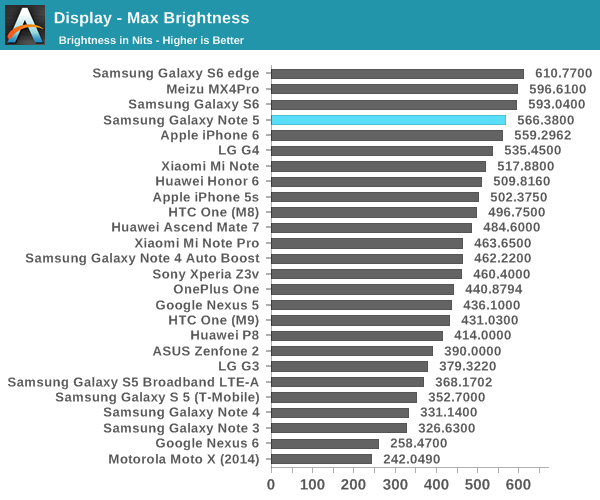
Moving on to our brightness testing, we can see that the Galaxy Note5 delivers a healthy improvement over the Galaxy Note 4 generation of AMOLED, but it isn’t quite at the same level as the Galaxy S6. It isn’t clear why this is the case, but I suspect this is related to longevity and other concerns outside of brightness. Meanwhile the use of OLED means that black levels are perfect and contrast remains solely determined by the lighting of the room and the reflectance of the display, which is similar to most other smartphones.
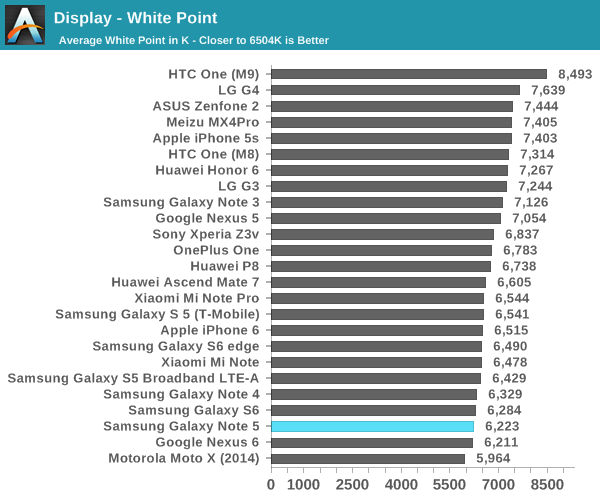
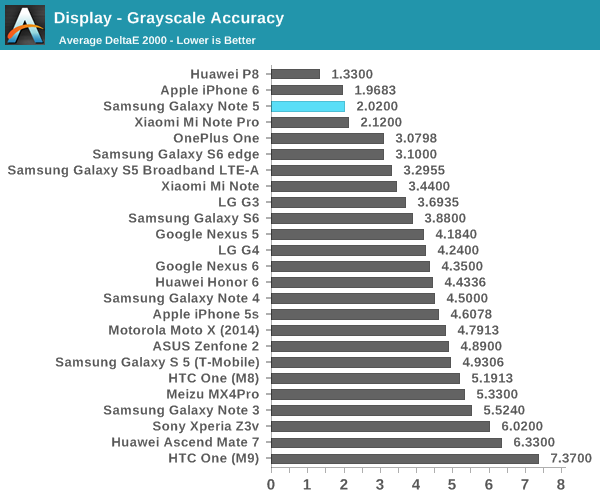
In our standard grayscale testing, the Note5 delivers acceptable color accuracy but it seems that the Basic screen mode tends towards a warm color balance. I suspect this helps with power efficiency, as blue in general requires more power to achieve the same level of luminance. Other than this slightly warm white balance, the grayscale accuracy doesn’t have any significant errors. This means accuracy ends up very good - certainly below our threshold for noticable errors - especially in comparison to the Galaxy Note 4 which had some noticeable problems with green tint on some units.
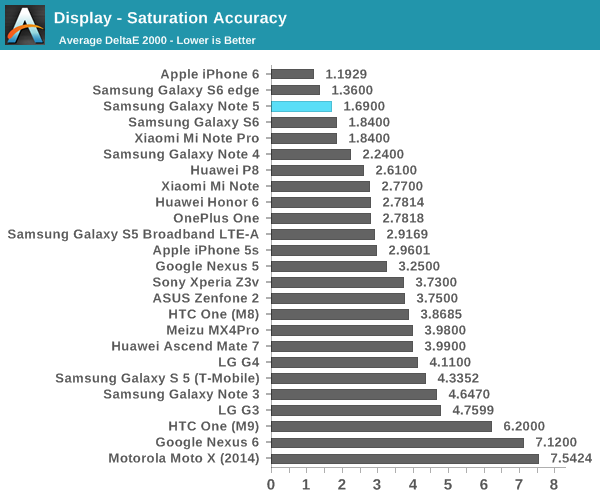
In our saturation test, Samsung does well enough that there’s really nothing to talk about because there's so little wrong here. You could argue that magenta is a bit warm on our review unit, but the difference is too small to be worth talking about. Error on average is going to be hard to spot unless you have a flawless reference monitor to compare against.
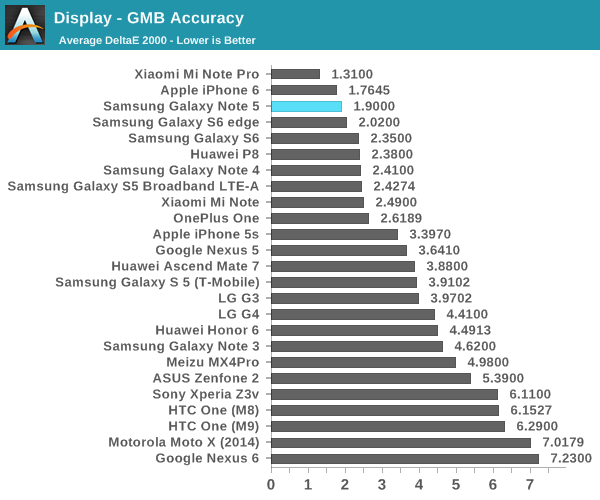
In the GMB ColorChecker test, Samsung continues to show a strong performance when looking at various hues that are commonly found in consumer content such as movies and camera photos. There’s a slight red shift on some of the tested hues, but the error is so minor I don’t notice that any problems here.
Overall, the Galaxy Note5 and Galaxy S6 edge+ both have an incredible display. The Galaxy S6 edge+ does have some problems with viewing angle shifts by virtue of the curved display, but this is effectively unavoidable given the subpixel layout and the radius of curvature. With this generation of AMOLED, Samsung has definitely equaled the best LCDs on the market. I suspect within the next year or two it will be inevitable that Samsung AMOLED will be clearly superior to even the best LCDs. However, without other OLED suppliers that can provide similar quality and cost I suspect OEM adoption will continue to be limited.



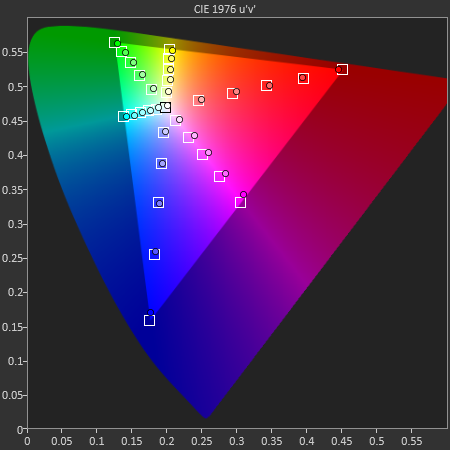
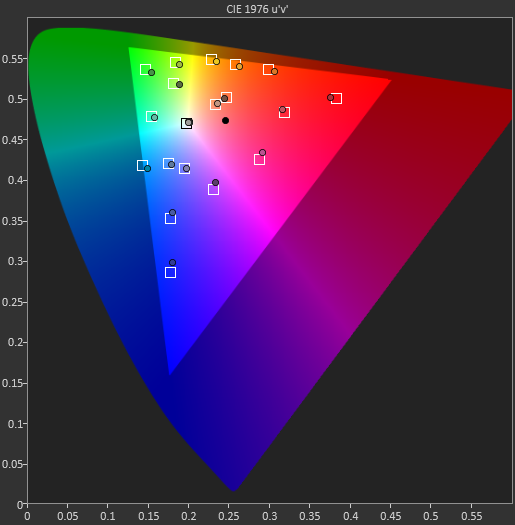








225 Comments
View All Comments
ciderrules - Tuesday, October 6, 2015 - link
Funny you picked the iPhone 6S and not the 6S Plus, which is a better comparison due to it having a larger screen and more "pixels to push".It scored 85 hours on their endurance rating, easily beating the GS6's 73 hours. Further, the 6S Plus beat last years 6 Plus even with a smaller battery. GS6 actually had less battery life than the GS5.
So Apple gives you the most powerful processor on the planet, decreases the battery size by 8%, and manages to increase battery life.
Kuzi - Tuesday, October 6, 2015 - link
iPhone 6s Plus is a phablet the same size of the Note 5, so should be compared with the Note 5 which gets the same rating of 85 too, but is pushing 1.7 times more pixels while offering faster multithreaded performance.ciderrules - Tuesday, October 6, 2015 - link
No, it's not faster. I already explained this to you before and you're still coming back and posting incorrect information again?Primate Labs (makers of Geekbench) rates the Note5 at 4351, the iPhone 6S/6S Plus at 4330/4331. So yes, the Note5 is a fraction of a percent faster in multi core performance.
Kuzi - Wednesday, October 7, 2015 - link
How many times do I have to explain that I own a Galaxy S6 and I get +5200 on Geekbench multicore test. I also own an Xperia Z4 tablet (SD 810 based) that gets +4800. So both are faster than A9 in multicore.Also GSMArena & Phonearena get similar results for exynos 7420 based devices as per below:
http://www.gsmarena.com/samsung_galaxy_note5-revie...
http://www.phonearena.com/news/Our-Samsung-Galaxy-...
There is some variance with each test run, and if the phone is warmer it gets slightly lower results. In my case the lowest I got was 5000 for GS6.
thedons1983 - Sunday, October 18, 2015 - link
What a fucki#g moron. You are pathetic!!coburn_c - Sunday, October 4, 2015 - link
Both curves of the plus have a disgusting green hue to them, and when you tilt it until one disappears, the entire front gets the baby poo greens. It is easily the worst viewing angle on any modern phone, and on an AMOLED of all places, a technology known for its viewing angles. I can't imagine how they could have screwed up worse.thedons1983 - Sunday, October 18, 2015 - link
Then you lack imagination... Apple has already made a worse phone for starters, or are you so ignorant, that you can't tell the difference between apples and oranges????theduckofdeath - Monday, October 5, 2015 - link
I wonder why Anandtech still had one standard for Samsung and one standard for everybody else when it comes to displays? I don't see you people scrutinise and down rank ocular quality issues with LCD displays like to do with AMOLED. AMOLED haven't just caught up to LCD this year, it's been superior for years, Anandtech. Fix your flawed and biased tests.Peichen - Monday, October 5, 2015 - link
If AMOLED is anywhere close to IPS why aren't EIZO, NEC, Dell switching their professional lineup to AMOLED? Why are 31" calibrated IPS monitors going for $3000 while the same money can get you 55" 4K OLED TV? For that matter, how come no one is selling a calibrated OLED anything? With all the green/purple tint and grayish white you'd think OLED could use some calibration.Leave the review to the professionals. Your eyeballing review aren't worth the hot air carrying the sound bits.
Kamus - Tuesday, October 6, 2015 - link
"The professionals" agree with him, go read displaymate's reviews.